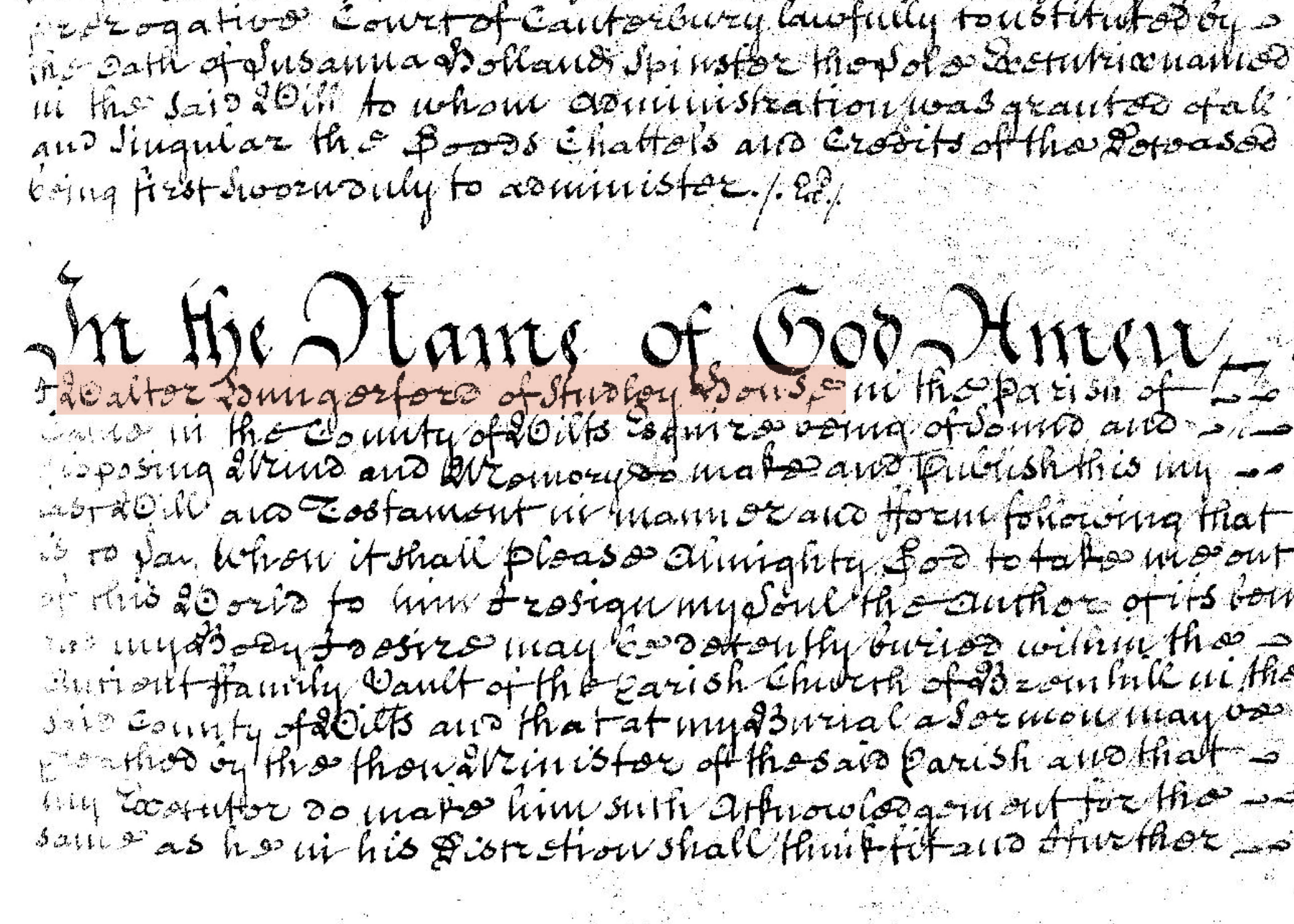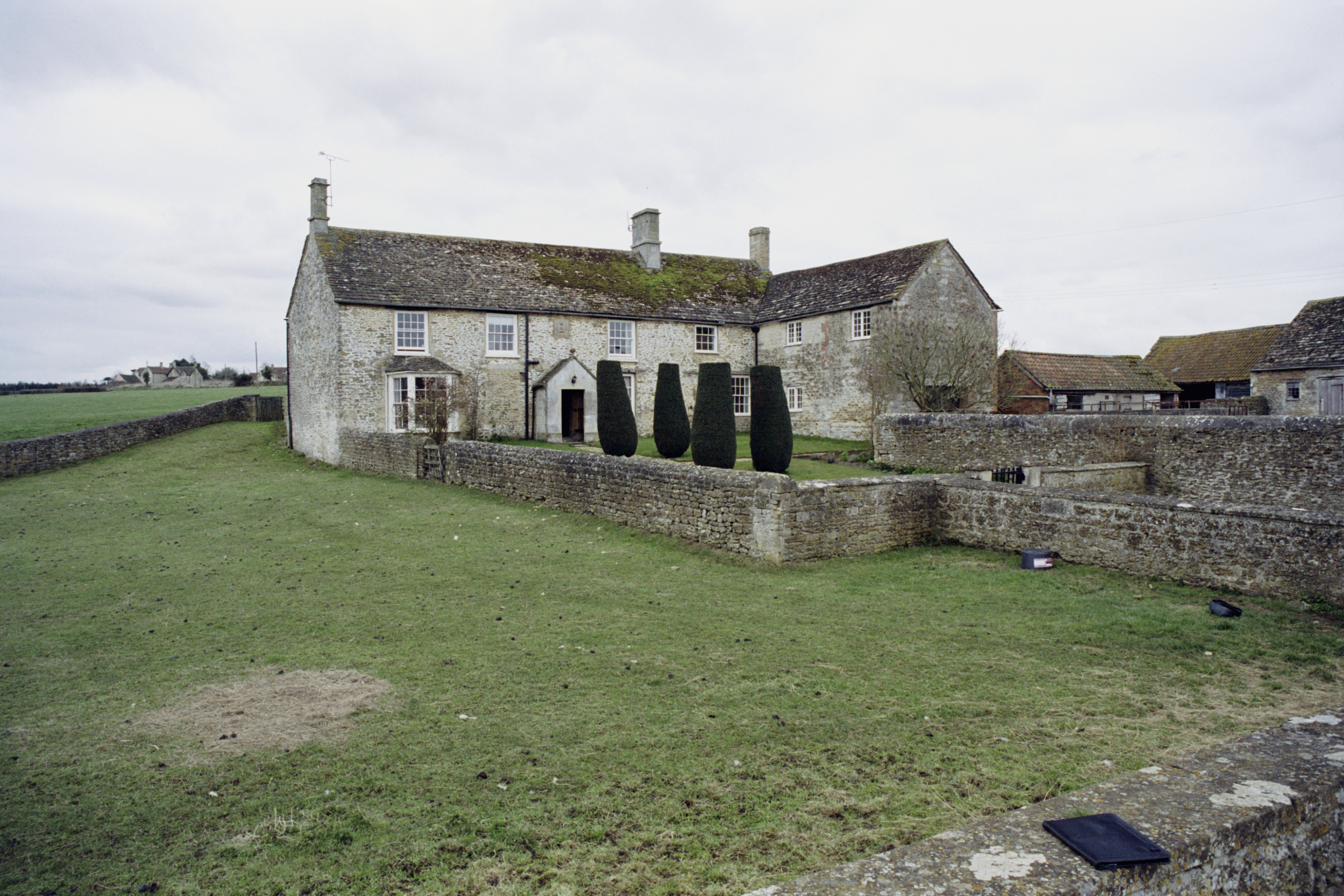Studley House was one of the most important and desirable properties mentioned in the Hungerford Deed and ultimately was awarded to Henrietta Maria Walker. Strangely, neither Studley House nor its counterpart, Great Durnford Manor, are listed in the schedules of properties parceled out to each sister, but it is clear from the records that Walker received Studley and Elizabeth Macie obtained Durnford. The property is located in the village of Studley, near a market town called Calne, about 100 miles west of London, in the county of Wiltshire.
There had been a manor house at Studley since at least 1240, but the building mentioned in the Deed is believed to have been built later, on the same site. Studley House belonged to a family called Norborne in 1611, but the Hungerfords acquired the home in the late seventeenth century—at least a few generations before the events described in the Hungerford Deed.1
 Studley House’s most famous inhabitant was likely Walter Hungerford, great-uncle to Walker, Macie, and their brother, Lumley Hungerford Keate. Walter was the heir to their family’s wealth after his elder brother, George, died prematurely (in fact, much of Walter’s social standing in life seems to have been due to opportunities vacated by his brother’s untimely death, including seats in Parliament and his position as heir).2 Studley House was Walter’s primary home and a base from which he acquired other local lands to gain greater wealth and influence. Walter had no children of his own. In his will, he left Studley House to his nephew, also named George Hungerford, and to George’s male heirs born to his wife. If George died early and without sons, a convoluted chain of inheritance clauses attempted to ensure that the lands Walter had acquired would remain in the hands of his family’s male descendants.3
Studley House’s most famous inhabitant was likely Walter Hungerford, great-uncle to Walker, Macie, and their brother, Lumley Hungerford Keate. Walter was the heir to their family’s wealth after his elder brother, George, died prematurely (in fact, much of Walter’s social standing in life seems to have been due to opportunities vacated by his brother’s untimely death, including seats in Parliament and his position as heir).2 Studley House was Walter’s primary home and a base from which he acquired other local lands to gain greater wealth and influence. Walter had no children of his own. In his will, he left Studley House to his nephew, also named George Hungerford, and to George’s male heirs born to his wife. If George died early and without sons, a convoluted chain of inheritance clauses attempted to ensure that the lands Walter had acquired would remain in the hands of his family’s male descendants.3
As it happened, nephew George lived long enough to inherit but not to father any sons, and his only daughter, Eliza, died young. Per the terms of Walter’s will, the house passed to John Keate, another nephew, and father of Macie, Walker, and their brother. If John were not alive, the claim would pass to his children. George, however, married again late in life, and his widow was determined to keep Studley for herself. So it was that in 1766, the year Lumley died, he was engaged in a lawsuit with the second Mrs. George Hungerford to obtain the coveted property.4
Lumley’s sisters took up his crusade in November 1766. With his death, his claim had passed to Macie and Walker, and they pursued the case energetically, referring to themselves within the suit against Mrs. Hungerford as “co-heiresses of Studley”—the same way James  Smithson would describe his mother in his own will in 1826.5 Walker and Macie ultimately succeeded. The case appears to have been decided at some point between January 1769, when Walker wrote despondently of spending the holiday near the beloved property, and July 1773, when the sisters began preparing to partition the family lands.6 As described in the Deed, plans went awry when Walker refused to execute the partition, and Macie took her to court in 1782.7 The Court of Chancery ruled in Macie’s favor, enforcing the division of properties, and each sister received her share of the spoils in 1787.
Smithson would describe his mother in his own will in 1826.5 Walker and Macie ultimately succeeded. The case appears to have been decided at some point between January 1769, when Walker wrote despondently of spending the holiday near the beloved property, and July 1773, when the sisters began preparing to partition the family lands.6 As described in the Deed, plans went awry when Walker refused to execute the partition, and Macie took her to court in 1782.7 The Court of Chancery ruled in Macie’s favor, enforcing the division of properties, and each sister received her share of the spoils in 1787.
A modern visitor to the site of Studley House would see something entirely different from what Walker took possession of after the Chancery case was settled. By 1800, Walker’s manor house was no longer standing, having burned down, and a farmhouse constructed from stone rubble (possibly from the ruins of Studley House) was built adjacent to where Walker’s beloved home had been.8 Walker herself died in 1803, suggesting that she may have had the dwelling constructed. The aristocratic Crewe family acquired the property when Walker’s daughter married the 2nd Baron Crewe. Their ownership is memorialized on a plaque, dated 1875, at the current house.9
Footnotes
1 “Calne: Calne outside the town,” in A History of the County of Wiltshire: Volume 17, Calne, ed. D.A. Crowley (London: Victoria County History, 2002), 51–64. British History Online, accessed July 27, 2021. Back to text
2 D.W. Dayton and Henry Lancaster, “HUNGERFORD, Walter (1675-1754), of St. Clement Danes, Westminster, and Studley House, nr. Calne, Wilts.” The History of Parliament: The House of Commons 1690–1715 [5 vols], eds. Eveline Cruickshanks, Stuart Handley, and David W. Dayton (Cambridge UP, 2002). The History of Parliament Online, accessed July 27, 2021 Back to text
3 Will of Walter Hungerford of Calne, Wiltshire, June 26, 1754, PROB 11/809/256, The National Archives, London. Back to text
4 Keate v Hungerford, 1764, C 12/1011/39, and Keate v Hungerford, 1765, C 12/1230/46, The National Archives, London; see also Heather Ewing, The Lost World of James Smithson: Science, Revolution, and the Birth of the Smithsonian (New York: Bloomsbury, 2007), 34. Back to text
5 For Macie and Walker’s suit against Elizabeth Hungerford, see Macie v Hungerford, 1766, C 12/1019/4, The National Archives, London. For Smithson’s will, see Draft of the Will of James Smithson, 1826, Record Unit 7000, Box 2, Smithsonian Institution Archives. Compare Will of James Smithson of Bentinck Street Cavendish Square, Middlesex, November 4, 1829, PROB 11/1763/129, The National Archives, London. Back to text
6 Ewing, The Lost World of James Smithson, 34. Back to text
7 Macie v Walker, 1782 (amended 1784), C 12/1261/38, The National Archives, London. Back to text
8 There is some confusion about precisely what happened to Studley House. Historic England, the English organization overseeing historic properties, states that the home burned down c. 1800, while a contemporary travelogue states the property had been pulled down by 1792, with no mention of a fire. The farmhouse built alongside is believed to have been built between 1776 and 1800. “Studley House Farm,” Historic England, accessed 27 July 2021; Archibald Robertson, A Topographical Survey of the Great Road from London to Bath and Bristol, vol. 2 (London: 1792), 60. See “Calne: Calne outside the town,” British History Online, for more information. Back to text
9 “Studley House Farm,” Historic England. Back to text
